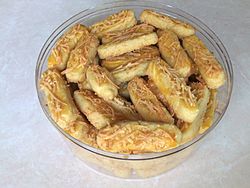Kaasstengels facts for kids

Kaasstengels in Indonesia
|
|
| Type | Cookie |
|---|---|
| Place of origin | Netherlands |
| Main ingredients | Flour, maizena, baking powder, egg yolks, butter or margarine, salt, sugar, cheddar cheese |
| Variations | Kastengel, kue keju (Indonesia) |
Kaasstengels (say "kahs-STEN-gels") are a tasty Dutch cheese snack. They are shaped like small sticks. Because of the Netherlands' history with Indonesia, you can also find kaasstengels there.
The name tells you about this snack. Kaas is the Dutch word for "cheese." Stengels means "sticks." So, kaasstengels are "cheese sticks."
Unlike most cookies, kaasstengels are not sweet. They taste savory and salty. In Indonesia, kaasstengels are very popular. People often eat them during special holidays. These include Natal (Christmas) and Lebaran (Eid al Fitr). They are served with other popular cookies like nastar and putri salju. In one Dutch city, Krabbendijke, kaasstengels have even been used like money!
How Kaasstengels Are Made
Making kaasstengels starts with a special dough. First, butter or margarine is mixed with egg yolks. Then, grated cheese is added to this mix. After that, flour, cornstarch, and baking powder are stirred in.
The dough is then rolled out. It is cut into small rectangle shapes. Before baking, the top of each piece is brushed with egg yolk. More grated cheddar cheese is sprinkled on top. Finally, the kaasstengels are baked until they are golden and crispy.
You can even make a vegan version of kaasstengels. Instead of cheese, bakers can use Nutritional yeast. This gives a cheesy flavor without using dairy products.
Kaasstengels vs. Kaastengels
It can be a bit confusing, but there are two different things with similar names! The kaasstengels we are talking about are the baked cheese cookies.
There is also something called Kaastengels. This is a Dutch brand of deep-fried finger food. These Kaastengels look like small spring rolls. They are filled with cheese and are deep-fried. The name Kaastengels comes from kaas (cheese) and tengels (fingers). So, they are like "cheese fingers."


